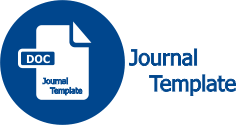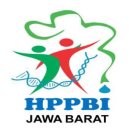Phytoplankton Community Structure in Bun-Bun River Waters, Kubu Raya Regency, West Kalimantan
DOI:
https://doi.org/10.25134/quagga.v16i2.59Keywords:
Brackish Waters, Bun-bun River, Community Structure, Phytoplankton, West KalimantanAbstract
The Bun-bun River was located in a mangrove forest area in Kubu Raya Regency and empties into the sea. As the main producers at the trophic level of waters, phytoplankton has an important role in assessing river quality. This study aims to find out phytoplankton community structure including abundance, diversity, uniformity, and dominance indexs in relation to Bun-bun River quality. The observations were made in the dry and rainy seasons at three stations starting from the initial end of the mangrove forest (Station 1), the middle (Station 2), and the final end which also empties into the sea (Station 3). Sampling was carried out at three points (left edge, center, right edge). Measurements of physico-chemical factors include brightness, current velocity, temperature, pH, DO, dissolved CO2, salinity, nitrate and phosphate. Phytoplankton sampling used a 30 µm plankton net mesh size and identification down to the species level. The calculated index values include abundance, diversity, uniformity, and dominance. The Bun-bun River was characterized by brackish waters with calm surface currents (<0.1 m.s-1) and a salinity between 5.4-9.48 ppt. Dissolved CO2 levels are relatively high, namely 22-30.8 mg.L-1 in the dry season and 35.2 mg.L-1 in the rainy season. During the dry season, the pH of the water becomes slightly acidic (6.51-6.76) and relatively neutral during the rainy season (7.08-7.52). Nitrate and phosphate levels were low in both seasons and all three stations. The brightness of the water was higher in the dry season than in the rainy season (20-44 cm). A total of 52 types of phytoplankton were found belonging to four classes, namely Class Bacillariophyceae (25 species), Dinophyceae (14), Chlorophyceae (12), and Chrysophyceae (1). Phytoplankton abundance index was low to moderate. The diversity index was moderate at almost all stations except for the low at Station 3 in the rainy season. The uniformity index at Station 3 was low in the dry season but high in the rainy season, and moderate in other locations. The dominance index was high at Station 3 during the dry season and moderate at other locations. Physico-chemical factors such as salinity, dissolved CO2, nitrate and phosphate levels are most likely to influence abundance, while diversity was influenced by dominance.
References
APHA, 2005. Standard Method for The Examination of Water and Wastewater. Washington DC: American Public Health.
Aryawati, R., Ulqodry, T. Z., Isnaini & Surbakti, H., 2021. Fitoplankton Sebagai Bioindikator Pencemaran Organik di Perairan Sungai Musi Bagian Hilir Sumatra Selatan. Jurnal Ilmu dan Teknologi Kelautan Tropis, 13(1), pp. 163-171.
Badan Pengelolaan Daerah Aliran Sungai dan Hutan Lindung (BPDASHL). 2022. Peta Administrasi Kecamatan Batu Ampar. Balai BPDASHL. Pontianak, Kalimantan Barat.
Biggs, B. & Kilroy, C., 2000. Identification Guide to Comon Peryphyton in New Zealand. New Zealand: NIWA.
Botes, L., 2003. Phytoplankton Identification Catalogue. Saldanha Bay: GloBallast Monograph.
Darmawan, A., Sulardiono, B. & Haeruddin, 2018. Analisis Kesuburan Perairan Berdasarkan Kelimpahan Fitoplankton, Nitrat dan Fosfat di Perairan Sungai Bengawan Solo Kota Surakarta. Journal of Maquares, 7(1), pp. 1-8.
Dwirastina, M. & Wibowo, A., 2015. Karakteristik Fisika-Kimia dan Struktur Komunitas Plankton Perairan Sungai Manna, Bengkulu Selatan. Jurnal Limnotek, 22(1), pp. 76-85.
Effendi, H. 2003. Telaah Kualitas Air : Bagi Pengolahan Sumber daya dan Lingkungan Perairan. Yogyakarta: Penerbit Kanisius.
Evita, I. N. M., Hariyati, R. & Hidayat, J. W., 2021. Kelimpahan dan Keanekaragaman Plankton Sebagai Bioindikator Kualitas Air di Perairan Pantai Sayung Kabupaten Demak Jawa Tengah. Jurnal Bioma, 23(1), pp. 25-32.
Fila, R., Nurcahyati, N. & Ardiyansyah, F., 2018. Kelimpahan Fitoplankton di Perairan Kawasan Mangrove Pulau Santen Banyuwangi. Jurnal Biosense, 2(1), pp. 38-50.
Gurning, L. F. P., Azizah, R., Suryono. 2020. Kelimpahan Fitoplankton Penyebab Harmful Algal Bloom di Perairan Desa Bedono, Demak. Journal of Marine Research, 9(3), pp. 251-260.
Haroon, A. M. & Hussian, A.-E. M., 2017. Ecological Assessment of the Macrophytes and Phytoplankton in El-Rayah Al-Behery, River Nile, Egypt,. The Egyptian Journal of Aquatic Research, 43(3), pp. 195-203.
Idrus, S. W. A. 2018. Analisis Kadar Karbon Dioksida di Sungai Ampenan Lombok. Jurnal Pijar MIPA, 13(2),pp. 167-170.
Irnawati, Indrayani, & Salwiyah. 2020. Keanekaragaman dan Kelimpahan Fitoplankton di Danau Motonuno Desa Lakarinta Kecamatan Lohia Kabupaten Muna, Sulawesi Tenggara. Jurnal Manajemen Sumber Daya Perairan,5 (2), pp.81-90.
Karl, D. M. 2000. Phosphorus, the Staff of Life. Nature, 406.pp. 31-33.
Kementerian Lingkungan Hidup. 2004. Kepmen LH No.51 Tahun 2004 Tentang Baku Mutu Air Laut. Menteri Negara Lingkungan Hidup. Jakarta.
Moore, C.M., Mills, M.M., Arrigo, K.R., Berman-Frank, I., Bopp,L., Boyd, P.W., Galbraith, E.D, et. al. 2013. Processes and Patterns of Oceanic Nutrient Limitation. Nature Geoscience, 6, pp.701-710.
Nontji, A. 2008. Plankton Laut. Jakarta: LIPI Press.
Novrilianty, H., Hudatwi, M. & Utami, E., 2022. Keanekaragaman Jenis Plankton di Perairan Batu Belubang dan Pulau Panjang Kabupaten Bangka Tengah Sebagai Indikator Kualitas Perairan. Jurnal Perikanan, 12(3), pp. 333-345.
Odum, E., 1993. Fundamental of Ecology. Phildalphia: W.B. Sounders Company.
Odum, E., 1998. Dasar-Dasarr Ekologi: Terjemahan dari Fundamental of Ecology. Alih Bahasa Samingan. 3nd penyunt. Yogyakarta: Universitas Gadjah Mada Press.
Paytan, Adina & McLaughlin, K. 2007. The Oceanic Phosphorus Cycle. Chem.Rev, 107, pp. 563-576.
Peraturan Pemerintah Republik Indonesia, 2021. Baku Mutu Air Laut untuk Biota Laut, Peraturan Pemerintah Republik Indonesia No. 22 Tahun 2021 Tentang Tentang Penyelenggaraan Perlindungan dan Pengelolaan Lingkungan Hidup. Jakarta.
Persulessy, M. & Arini, I. 2018. Keanekaragaman Jenis dan Kepadatan Gastropoda di Berbagai Substrat Bekarang di Perairan Pantai Tihunitu Kecamatan Pulau Haruku Kabupaten Maluku Tengah. Biopendi, 5(1), pp. 45-52.
Prescott, G., 1964. The Fresh Water Algae. Michigan: WM.C. Brown Company Publishers.
Rahman, M. 2016 . Produktivitas Primer Perairan Pantai Kawasan Hutan Mangrove Desa Pagatan Besar Kecamatan Takisung Kabupaten Tanah Laut Propinsi Kalimantan Selatan. Jurnal Ilmu-Ilmu Perikanan dan Kelautan, 6(11), pp. 11-24.
Raymont, J., 1980. Plankton and Productivity in The Ocean. Mc. Milan : A Pergamin Press Book.
Sari, A. N., Hutabarat, S. & Soedarsono, P., 2014 .Struktur Komunitas Plankton pada Padang Lamun di Pantai Pulau Panjang, Jepara. Journal Management of Aquatic Resources, 3(2), pp. 82-91.
Sukawati, N. K. A., Restu, I. W. & Saraswati, S. A., 2018. Sebaran dan Struktur Komunitas Moluska di Pantai Mertasari Kota Denpasar, Provinsi Bali. Journal of Marine and Aquatic Science, 4(1), pp. 78-85.
Sulistiowati, D., Tanjung, R. H. & Lantang, D., 2016. Keragaman dan Kelimpahan Plankton Sebagai Bioindikator KualitasLingkungan di Perairan Pantai Jayapura. Jurnal Biologi Papua, 8(2), pp. 79-96.
Syafriani, R. & Apriadi, T., 2017 Keanekaragaman Fitoplankton di Perairan Estuari Sei Terusan, Kota Tanjungpinang. Keanekaragaman Fitoplankton Di Perairan Estuari Sei Terusan, Kota Tanjungpinang. Jurnal Limnotek: Perairan Darat Tropis di Indonesia, 24(2), pp. 74-82.
Tomas, C.R., 1997. Identifying Marine Phytoplankton. America: Academic Press.
Vuuren, S., T, J., G, C. v. & Gerber, A., 2006. Easy Identification of The Most Common Freshwater Algae. South African: North-West University.
Whittington,, J., Sherman, B., Green, D., & Oliver, R.L. 2000. Growth of Ceratium hirundinella in a Subtropical Australian Reservoir: the Role of Vertical Migration. Journal of Plankton Research, 22(6), pp.1025–1045.
Yuliana. (2015). Distribusi dan Struktur Komunitas Fitoplankton di Perairan Jailolo, Halmahera Barat. Jurnal Akuatika, 1, pp. 41-48.
Downloads
Published
How to Cite
Issue
Section
License
Copyright (c) 2024 Uci Ramadhani, Entin Daningsih, Wolly Candramila

This work is licensed under a Creative Commons Attribution-ShareAlike 4.0 International License.




















